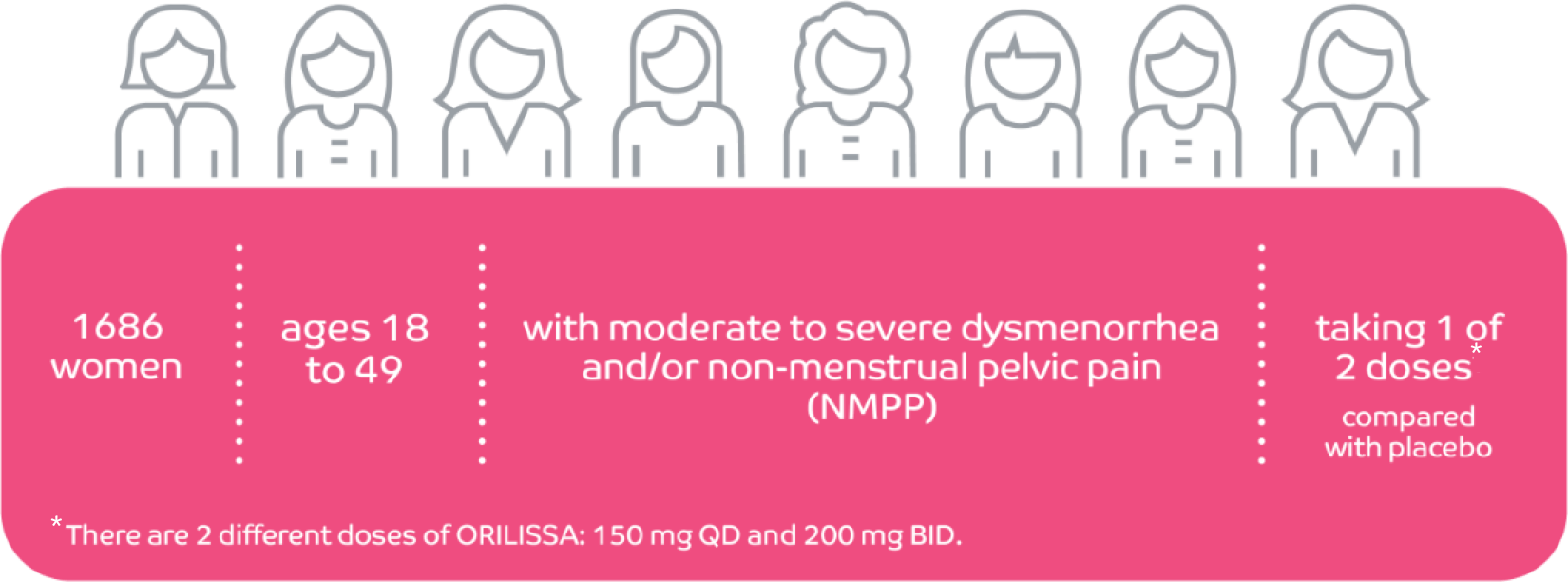ORILISSA was rigorously studied to determine its effectiveness and safety profile1
The efficacy, safety, and tolerability of ORILISSA were demonstrated in the largest endometriosis Phase 3 study program to date (N=1686)1,2

- Two robust, similar, multicenter, double-blind, placebo-controlled Phase 3 trials (ELARIS EM-1and ELARIS EM-2) of 6-month treatment at 2 doses as compared with placebo1
- Patients who entered the studies had endometriosis pain that was beyond mild, and ~88% reported having at least 1 previous medical treatment for their pain1,3
- Women were surgically diagnosed (laparoscopy or laparotomy) with endometriosis in the last 10 years2
Endpoints
Co-primary endpoints1,2
- Proportion of responders for dysmenorrhea at month 3 compared with placebo†
- Proportion of responders for NMPP at month 3 compared with placebo†
Responder1,2
Rigorous responder
definition included both:
Clinically meaningful
pain reduction†
AND
Stable or decreased
NSAID or opioid use
Select ranked secondary endpoints1,2
- Change from baseline to month 6 in dysmenorrhea on the Endometriosis Daily Pain Impact Scale
- Change from baseline to month 6 in non-menstrual pelvic pain on the Endometriosis Daily Pain Impact Scale
- Change from baseline to month 3 in dyspareunia on the Endometriosis Daily Pain Impact Scale
- Only participants who were sexually active during the trial were included in the results for dyspareunia
†Women were defined as responders if they experienced clinically meaningful pain reduction and stable/decreased rescue analgesic use for endometriosis-associated pain. Clinically meaningful reduction in pain was defined as a calculated threshold of improvement in pain score in each study. The threshold was determined based on an analysis of the change in pain score that corresponded to “much improved” or “very much improved” on the Patient Global Impression of Change questionnaire.
Endometriosis Daily Pain Impact Scale1,2
Patients participating in ELARIS EM-1 and EM-2 recorded their pain levels and the effect on their activities over the previous 24-hour period in a daily diary using the Endometriosis Daily Pain Impact Scale. They used the following pain scales with a scoring system and a functional component for each score.
Dysmenorrhea and non-menstrual pelvic pain
3
Severe
I had great difficulty doing things I usually do.
2
Moderate
I had some difficulty doing things I usually do.
1
Mild
I was easily able to do things I usually do.
0
None
No discomfort.
Dyspareunia
3
Severe
I avoided sexual intercourse because of pain.
2
Moderate
Intercourse was interrupted due to pain.
1
Mild
I was able to tolerate the discomfort during sexual intercourse.
0
None
No discomfort during sexual intercourse.
NA
I was not sexually active for reasons other than my endometriosis or did not have sexual intercourse.
Indication and Important Safety Information
INDICATION1
ORILISSA® (elagolix) is indicated for the management of moderate to severe pain associated with endometriosis.
IMPORTANT SAFETY INFORMATION1
CONTRAINDICATIONS
- ORILISSA is contraindicated in women who are pregnant (exposure to ORILISSA early in pregnancy may increase the risk of early pregnancy loss), in women with known osteoporosis or severe hepatic impairment, or with concomitant use of strong organic anion transporting polypeptide (OATP) 1B1 inhibitors (e.g., cyclosporine and gemfibrozil).
WARNINGS AND PRECAUTIONS
Bone Loss
- ORILISSA causes a dose-dependent decrease in bone mineral density (BMD), which is greater with increasing duration of use and may not be completely reversible after stopping treatment.
- The impact of ORILISSA-associated decreases in BMD on long-term bone health and future fracture risk is unknown. Consider assessment of BMD in patients with a history of low-trauma fracture or other risk factors for osteoporosis or bone loss, and do not use in women with known osteoporosis.
- Limit the duration of use to reduce the extent of bone loss.
Change in Menstrual Bleeding Pattern and Reduced Ability to Recognize Pregnancy
- Women who take ORILISSA may experience a reduction in the amount, intensity, or duration of menstrual bleeding, which may reduce the ability to recognize the occurrence of pregnancy in a timely manner. Perform pregnancy testing if pregnancy is suspected, and discontinue ORILISSA if pregnancy is confirmed.
Suicidal Ideation, Suicidal Behavior, and Exacerbation of Mood Disorders
- Suicidal ideation and behavior, including one completed suicide, occurred in subjects treated with ORILISSA in the endometriosis clinical trials.
- ORILISSA users had a higher incidence of depression and mood changes compared to placebo and ORILISSA users with a history of suicidality or depression had an increased incidence of depression. Promptly evaluate patients with depressive symptoms to determine whether the risks of continued therapy outweigh the benefits. Patients with new or worsening depression, anxiety, or other mood changes should be referred to a mental health professional, as appropriate.
- Advise patients to seek immediate medical attention for suicidal ideation and behavior. Reevaluate the benefits and risks of continuing ORILISSA if such events occur.
Hepatic Transaminase Elevations
- In clinical trials, dose-dependent elevations of serum alanine aminotransferase (ALT) at least 3 times the upper limit of the reference range occurred with ORILISSA.
- Use the lowest effective dose and instruct patients to promptly seek medical attention in case of symptoms or signs that may reflect liver injury, such as jaundice.
- Promptly evaluate patients with elevations in liver tests to determine whether the benefits of continued therapy outweigh the risks.
Reduced Efficacy with Estrogen-Containing Contraceptives
- Based on the mechanism of action of ORILISSA, estrogen-containing contraceptives are expected to reduce the efficacy of ORILISSA. The effect of progestin-only contraceptives on the efficacy of ORILISSA is unknown.
- Advise women to use non-hormonal contraceptives during treatment and for one week after discontinuing ORILISSA.
ADVERSE REACTIONS
- The most common adverse reactions (>5%) in clinical trials included hot flushes and night sweats, headache, nausea, insomnia, amenorrhea, anxiety, arthralgia, depression-related adverse reactions, and mood changes.
These are not all the possible side effects of ORILISSA.
Safety and effectiveness of ORILISSA in patients less than 18 years of age have not been established.
US-ORIL-200330
For more information, please click here for full Prescribing Information.
References:
1. ORILISSA [package insert]. North Chicago, IL: AbbVie Inc. 2. Taylor HS, Giudice LC, Lessey BA, et al. Treatment of endometriosis-associated pain with elagolix, an oral GnRH antagonist. N Engl J Med. 2017;377(1):28-40. 3. Data on file. ABVRRTI65829.




